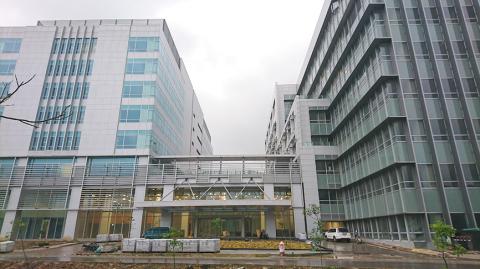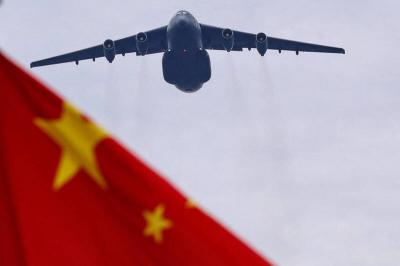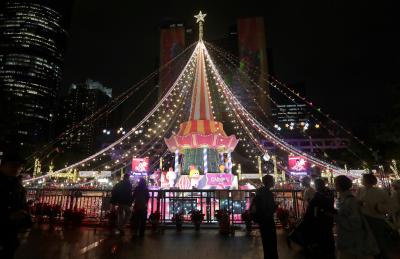Encumbered by property and environmental controversies for more than a decade, the National Biotechnology Research Park in Taipei’s Nangang District (南港) is slated for completion on Wednesday, Academia Sinica officials said.
Once completed, the park’s seven buildings are to accommodate the Ministry of Health and Welfare’s Food and Drug Administration, the Ministry of Science and Technology’s National Laboratory Animal Center, the Ministry of Economic Affairs’ Development Center for Biotechnology, an incubation center, two Academia Sinica research centers, and a bioinformatics center.
The project, with a development budget of about NT$22.5 billion (US$767.92 million), is managed by a special committee made up of seven ranking officials from Academia Sinica — the nation’s highest research institution — and the three ministries.

Photo provided by Academia Sinica
It is “very exciting” to mark the completion of a “tremendous project” that is so critical to the growth of the nation’s biotechnological sector, said Academia Vice President Liu Fu-tong (劉扶東), who serves as committee head.
Located near Academia Sinica and the Nangang MRT Station, the park covers 25.44 hectares that used to house the Ministry of National Defense’s 202nd Arsenal.
The land was designated as the park’s site during former president Chen Shui-bian’s (陳水扁) presidency, and the construction project was launched in 2007 by then-Academia Sinica president Wong Chi-huey (翁啟惠).
Wong’s indictment in 2016 on insider trading, corruption and misconduct charges involving biotech company OBI Pharma Inc (台灣浩鼎) case, which the Taipei Shilin District Prosecutors’ Office dropped last month, led to his resignation in May that year, making him unfit to continue leading the project.
There had been speculation that the project might be further delayed. Former president Ma Ying-jeou (馬英九) and President Tsai Ying-wen (蔡英文) each expressed concern about its progress.
Tsai, who helped negotiate the land use when she served as vice premier, in June last year said the park’s construction would be completed by the end of last year.
Academia Sinica President James Liao (廖俊智) was on Feb. 21 quoted by the Chinese-language Economic Daily News as saying that he expected “part of” the park to be inaugurated by May 20 and the first business to have been attracted by the end of April.
In an interview with the Taipei Times on Friday last week, Liu said the institution had obtained all the architectural licenses for the buildings by Feb. 14 and expected to mark the park’s completion on Wednesday.
However, he added that the date of its formal inauguration was yet to be determined.
Initial controversy over land use was the main reason for delays, as it took about six years for the Ministry of National Defense to hand over the land, Liu said.
One of the most vehement opponents to the project, literary writer Chang Hsiao-feng (張曉風), said the construction project would destroy a precious wetland on the site — what she called “the last lung lobe of Taipei.”
When construction was about to begin in 2010, Chang even knelt down in front of the media in a call to then-president Ma to stop exploiting the land.
It was not until 2014 that the park’s construction actually began and other factors, such as the environmental impact assessment process, heavy rainfall impeding construction and difficult deployment of workers, led to further delays, Liu said.
“Its construction can be said to be the nation’s most challenging project ever,” especially as great effort was put toward environmental protection, Academia Department of General Affairs director Fan I-chun (范毅軍) said.
The land is historically and ecologically valuable as it contains the Sanchongpu Pond (三重埔埤), which can be traced back to at least the Japanese colonial period, he said, adding that it is home to a great variety of wetland creatures.
To minimize the project’s environmental effect, the institution reserved 14.19 hectares — over half of the total development area — as a forested area and 4 hectares as a wetland.
The developers are confident that the past environment has been successfully restored, with its ecological conditions even better than a century ago, Fan said.
Some of the institution’s retired researchers have scrutinized the park’s construction carefully recording the number of organisms there, Academia Secretary-General Peng Shin-kun (彭信坤) said.
With the park’s inauguration, the institution can join and strengthen the local biotechnology sector, given that “lacking connection with industries is one of its shortcomings,” he said.
Meanwhile, the Hsinchu Biomedical Science Park, planned by the Ministry of Science and Technology at a budget of NT$2.85 billion, is now under construction on a 38.1-hectare site near Hsinchu High Speed Rail Station.
All spaces in its two buildings have been rented out, with more firms seeking to enter the park, the ministry said at a groundbreaking ceremony for the park’s second biotechnological building last month.
Asked if the two parks are vying for business investment, Liu said that the Nangang park seeks to draw medicine producers and biomedical translational researchers, while the one in Hsinchu focuses on developers of medical devices.
A call for applications from biotech businesses wanting to move into the Incubation Center in Nangang has been announced and many have expressed interest in joining the park, he said, without providing a timetable for business solicitation.
The park would become a “one-stop shop” for biotech firms, given that it has pooled resources from academia, the government and research agencies, he said.
Unlike the fast progress in the information and communication technology, new drug development often takes more than 10 years, as developers must conduct a series of clinical trials and pass approval procedures, he said.
Nonetheless, the institution aims to promote research and development related to biotechnology, he said.
“How the park will be operated and which [research and development] subjects should be tackled first” are questions that must be answered, Liu said.
“Nangang has always been regarded one of the most backward regions in Taipei,” Fan said. “Hopefully, after the park opens, it will become the city’s most advanced area.”
Beyond the restored wetland at the park, the 202nd Arsenal lies long disused on the other side of a wall.

Beijing could eventually see a full amphibious invasion of Taiwan as the only "prudent" way to bring about unification, the US Department of Defense said in a newly released annual report to Congress. The Pentagon's "Annual Report to Congress: Military and Security Developments Involving the People's Republic of China 2025," was in many ways similar to last year’s report but reorganized the analysis of the options China has to take over Taiwan. Generally, according to the report, Chinese leaders view the People's Liberation Army's (PLA) capabilities for a Taiwan campaign as improving, but they remain uncertain about its readiness to successfully seize

Taiwan is getting a day off on Christmas for the first time in 25 years. The change comes after opposition parties passed a law earlier this year to add or restore five public holidays, including Constitution Day, which falls on today, Dec. 25. The day marks the 1947 adoption of the constitution of the Republic of China, as the government in Taipei is formally known. Back then the Chinese Nationalist Party (KMT) governed China from Nanjing. When the KMT, now an opposition party in Taiwan, passed the legislation on holidays, it said that they would help “commemorate the history of national development.” That

Taiwan has overtaken South Korea this year in per capita income for the first time in 23 years, IMF data showed. Per capita income is a nation’s GDP divided by the total population, used to compare average wealth levels across countries. Taiwan also beat Japan this year on per capita income, after surpassing it for the first time last year, US magazine Newsweek reported yesterday. Across Asia, Taiwan ranked fourth for per capita income at US$37,827 this year due to sustained economic growth, the report said. In the top three spots were Singapore, Macau and Hong Kong, it said. South

Snow fell on Yushan (Jade Mountain, 玉山) yesterday morning as a continental cold air mass sent temperatures below freezing on Taiwan’s tallest peak, the Central Weather Administration (CWA) said. Snowflakes were seen on Yushan’s north peak from 6:28am to 6:38am, but they did not fully cover the ground and no accumulation was recorded, the CWA said. As of 7:42am, the lowest temperature recorded across Taiwan was minus-5.5°C at Yushan’s Fengkou observatory and minus-4.7°C at the Yushan observatory, CWA data showed. On Hehuanshan (合歡山) in Nantou County, a low of 1.3°C was recorded at 6:39pm, when ice pellets fell at Songsyue Lodge (松雪樓), a